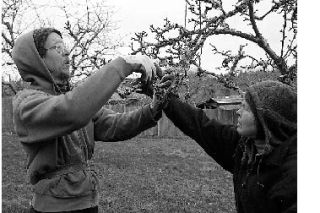It’s time to prune fruit trees and there are many print and Internet resources for guidance if you’re new to pruning or want to review. Another great resource is friends with experience pruning who will let you tag along as they prune.
Scott and I were lucky to spend a morning recently with our neighbors Kevin Murphy and Mary Hayton as they began pruning apple, pear and plum trees in their orchard. Watching them, we observed basic pruning techniques and reasons for them and saw how careful pruning over many years creates beautiful trees.
Standing in front of the youngest tree in their orchard, a four-year-old Honey Crisp he’d transplanted from another site, Kevin said, “I’m not going to do much pruning on this tree because it hasn’t grown enough.”
Pointing to the lower branches and spurs, he and Mary explained that they’d leave them for now because they are feeding and strengthening the trunk. When he does start to prune it, Kevin continued, “I’ll have to decide where I want the lowest branch to start, depending on the vigor. Everything below that I’ll take off.” Describing what will happen in subsequent years, he added, “I usually go with a modified central leader, so I’ll let the trunk grow up and let three or four branches grow evenly up the trunk. Then I’ll start topping.”
Turning to a Asian pear tree that illustrated central leader pruning, Kevin pointed out that it “branches evenly all the way up while a modified would only branch up part way and then open up into a vase shape.” “I actually like the central leader the best as far as pruning,” he said. “It’s the easiest to prune and there’s always the most growth to prune to, so the most choices.”
Moving on to an older Melrose apple tree, Kevin said that with this mature tree he usually plans on removing about a third of the growth. Starting to cut, he explained: “dead growth comes off first, then I’ll do the crossing ones, then I’ll shorten new growth to stiffen up the branches.” “I always think of stiffening a branch,” he added. “Branches that get too long get floppy.”
This Melrose illustrated another challenge: “it lost its top and is kind of growing all to one side. When I’m pruning it I’m favoring it growing to the other side. What I would love is to have a shoot grow straight up from the trunk. It’s been spending a lot of time healing itself so that will take time to restore its shape.”
“In the end I always go for the shape,” he added. “It gives a different take on the pruning. It’s not just this chore to cut the trees. You’re also making them beautiful.”
As we walked through the rest of the orchard, Kevin and Mary shared other tips. “A mistake people make is taking off all the upright growth. People lop one off but the next year they get two. What we try to do is to keep the weakest of the shoots to get a new branch or fruiting spur.” Examining clusters of fruit spurs at the ends of branches they said that they often cut off old, shriveled spurs to reduce crowding and to promote younger, thicker spurs.
Perhaps the most useful tip from this pair of experienced pruners is that along with the books and the videos, you just have to get out there and do it and then be observant. “For a while we’d go back to the same tree each year and really discuss. That helped a lot. And you always get the next year to correct,” they added, laughing.
Reflecting on what they enjoy about pruning, Mary said: “I like to look at the tree that I’ve reshaped or just thinned out.” Kevin added, “It’s the year-to-year experience, seeing the results of what you’ve done.”
Two books Kevin and Mary recommend for training and pruning of all of the orchard fruits are Growing Fruit by Harry Baker and Pruning by Christopher Brickell. On the Internet, Scott enjoyed a series of video tutorials on pruning apple trees. http://www.youtube.com/watch?v=Q_jqgWXlUHM And with all the small home orchards on Lopez, there are lots of friends who’ll share their pruning skills.



